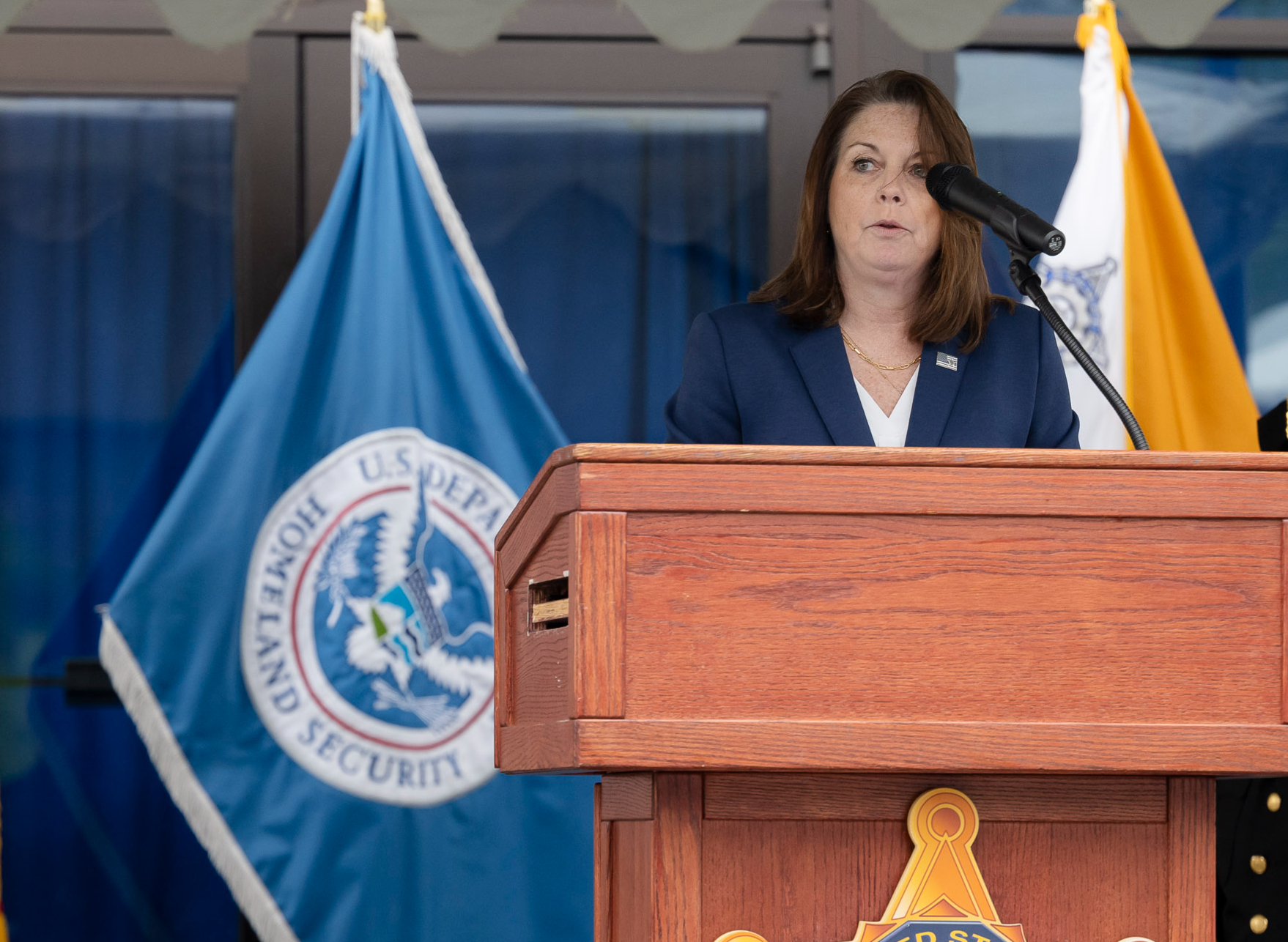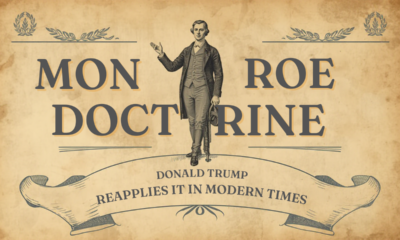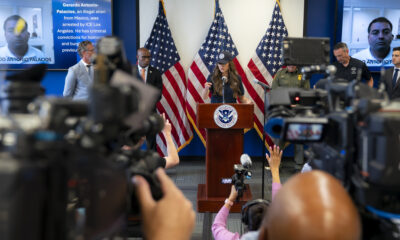Executive
GOP, Dems Unite in Calls for Secret Service Director To Resign
Both Republican and Democratic members of the House Oversight Committee yesterday called on Secret Service Director Kim Cheatle to resign.

Infuriated members of Congress probing the attempted assassination of Donald Trump castigated Secret Service Director Kimberly Cheatle on Monday for her lack of transparency and candor during more than four hours of testimony before the House Oversight Committee as bipartisan calls intensified for her to step down.
From Comer and Raskin to Secret Service Chief Cheatle: resign
In a letter released after the hearing, House Oversight Committee Chairman James Comer, a Kentucky Republican, and Rep. Jamie Raskin, the ranking Democratic member, urged Cheatle to resign.
“Today, you failed to provide answers to basic questions regarding that stunning operational failure and to reassure the American people that the Secret Service has learned its lessons and begun to correct its systemic blunders and failures,” they wrote. “In the middle of a presidential election, the Committee and the American people demand serious institutional accountability and transparency that you are not providing.”
But even the small shards of information Cheatle disclosed to the panel coupled with initial findings from members of Congress are providing significant clues about the security breakdowns that led to a gunman nearly killing President Trump, while murdering a rally-goer and injuring two others.
Over the last 48 hours, lawmakers who have talked to whistleblowers and local law enforcement are zeroing in on a troubling disconnect between the Secret Service and local law enforcement communications that may have contributed to a delay in the Secret Service recognizing 20-year-old Thomas Matthew Crooks as a serious threat and only firing on him after he had fired upon Trump and the crowd.
Local police snipers first flagged Crooks as suspicious nearly an hour before he fired off the shots that pierced Trump’s right ear and killed Corey Comperatore and injured two others.
Crooks looked suspicious nearly an hour before he fired his shots
Although Crooks wasn’t armed at first, he looked so suspicious that a local law enforcement sniper positioned either at or in the American Glass Research building took two photos of him at 5:14 p.m. and another of a bike and a backpack near the building, though it is still unclear whether those items are associated with Crooks.
At that point, concerns only increased when the government sniper observed Crooks holding a range finder while still on the ground and looking at news feeds on his phone. Shortly after seeing the range finder, the local law enforcement sniper called into his own local command unit at 5:41 and described Crooks and noted that he had the device.
Four minutes later, he relayed his concerns about Crooks in a group text to other local law enforcement personnel on site and was instructed to report the suspect to a Beaver County police command unit.
It was not until 5:59 that a Beaver County law enforcement operator confirmed to a Butler County SWAT command that the main Secret Service command center was made aware of the messages and requested more information about the suspect’s location, the Johnson report said.
At 6:02 Trump took the stage as “God Bless America” played on a public address system.
The event
At 6:05, the former president began addressing the crowd, and at 6:09, several attendees on the outskirts of the rally noticed that Crooks was armed and crawling on the nearby roof less than 150 yards from the stage of Trump’s rally and shouting to law enforcement to do something about it.
A Butler township police officer ran from his role managing traffic and tried to follow the shooter onto the roof but fell off when Crooks aimed his weapon at him. At 6:11 p.m. shots rang out and Trump initially fell to the ground with agents piling on top of him. Seconds later a Secret Service counter sniper killed Crooks with one shot to the head.
The breakdown between local law enforcement and the Secret Service’s communications squandered the time in which the Secret Service should have sent out an investigative team to interview Crooks or pursue him if he fled, according to sources within the Secret Service community.
“A [Secret Service] investigative team should’ve gone out and gotten the kid, if they were called,” a source told RCP.
Yet, the Secret Service agency has not produced a detailed timeline of when local law enforcement first flagged them about a security concern regarding Crooks.
Secret Service relied on local law enforcement outside their perimeter
Sources within the Secret Service community have said that the agency relied on local law enforcement for protection outside of the area designated as the official event perimeter, which included the American Glass Research building where Crooks perched and fired his weapon at Trump and the crowd. Even though it’s normal for local police to monitor the area outside the perimeter and deal with the traffic, the decision not to include that building within the perimeter is now cited as a glaring mistake.
Just why it took so long for local law enforcement to transfer important messages to the Secret Service is still a mystery. Cheatle herself testified that the Secret Service has “local counterparts” in a command center, which are usually located offsite, to help facilitate communications between the Secret Service personnel on the ground and local law enforcement.
During questioning by Rep. Russell Fry, a South Carolina Republican, Cheatle was asked whether the agency provides radios for all assets on the ground and whether all the radios use the same frequency.
Instead of responding directly, Cheatle said the agency takes steps to ensure “interoperability.”
“We ensure that we have counterparts in the security room [at the command center],” she told the panel. “So local law enforcement will place one of their personnel in the security room with our personnel, so we have interoperability with communications.”
Was local law enforcement even represented?
Yet, there is no evidence that a representative for local law enforcement was present at the Secret Service command center that day as reports circulated among local law enforcement that Crooks appeared suspicious, according to interviews with members of Congress and an initial fact-finding report produced by GOP Sen. Ron Johnson. The Johnson report says local law enforcement has told him and his staff that communications were “siloed” and “they were not in frequent radio contact directly with the Secret Service.”
The report also goes on to say that local SWAT and sniper teams operated on separate radio channels from patrol. According to these individuals, communications had to be routed to a Butler local police command, who would then relay information to either Secret Service or other local law enforcement patrols for decision-making.
“It is unclear why communications were set up this way and whether the lack of direct communications between local law enforcement and Secret Service hindered any response time,” the Johnson report states.
A source in the Secret Service community told RealClearPolitics that “it isn’t feasible or sound operationally to mix the police and Secret Service on the same frequency.”
“That’s why there’s a command center where representatives for the Secret Service and local police are together,” he said.
What is Rep. Thompson talking about?
Yet Rep. Bennie Thompson, the ranking member of the House Homeland Security Committee, said he and other committee members met with local officials and police in Butler Sunday and early Monday and also heard about a communication breakdown between federal, state, and local authorities.
“I know that [local law enforcement] did not have, based on testimony from locals, somebody in the command center,” Thompson told RCP in an interview Monday afternoon.
During Monday’s contentious hearing, Cheatle said the opposite – that normal agency protocols ensure “interoperability of communications” by placing a member of the local law enforcement team in the command center with senior members of the Secret Service.
When pressed on the details, she repeatedly cited the ongoing criminal FBI investigation as a reason not to disclose many details about personnel on the ground or a timeline of events leading up to Crooks firing his father’s AR-15 at Trump and the crowd. After his visit to Butler this week, Thompson said he sympathized with local officials who told him they only knew about the event a couple of days before it was scheduled to take place and may have been rushed. CNN has reported that Trump’s rally that day was supposed to take place at the Butler airport, where he had held a rally in 2020. But the airport was already booked for another event, so the Butler County Farm Show venue was selected as an alternative.
The Secret Service rushed their preparations
Sources have told RCP that the Secret Service counter sniper team assigned to conduct a detailed survey of vulnerabilities at the site would usually start its work for such a big, outdoor venue two to three days before the scheduled rally. But in this case, the counter sniper was only given one day, the day before the event, to do that detailed work.
If the Secret Service was rushing to make the Farm Show venue work on too tight a schedule, Thompson said someone needed to come forward and say it’s not going to work and either tell Trump the event must be canceled or re-scheduled at another site.
“Somebody has to say, ‘Whoa, we don’t have enough time to secure this location,’” he said. “And that was the point more than anything else.”
Responsibility Without Accountability
Although Cheatle acknowledged the attack in Butler as “the most significant operational failure” in decades, she said she takes full responsibility for it, though she said she would not resign and insisted to incredulous members of Congress that she was still the best person to lead the agency.
Late in the day after hours of stonewalling, Cheatle wouldn’t even commit to firing Secret Service officials determined to have failed in their jobs that day. A frustrated Rep. Jared Moskowitz, a Democrat, lashed out at her. Moskowitz, who represents Parkland, Florida, the scene of a horrific 2018 mass shooting at a high school, told Cheatle that her response reminded him of a local sheriff who wouldn’t even fire a school resource officer who hid in the stairwell that day and refused to enter the building. “Gov. DeSantis then removed that sheriff,” he said. “I supported that removal.”
Comparison to the university antisemitism hearing
In one of the most dramatic moments of the hearing, Moskowitz continued, “Director, I just want to give you an honest assessment of how this is going for you today: Did you happen to catch the hearing many months ago in education where there were a bunch of university presidents and Elise Stefanik asked a very easy question and couldn’t get an answer? Did you see that hearing? Stefanik asked a very easy question and couldn’t get an answer. … And the short end of that story was those university professors all resigned. They’re gone. That’s how this is going for you. This is where this is headed.”
“I don’t know who prepared you for this,” the Florida Democrat continued. “I don’t know how many times you’ve testified in front of Congress, but a president was almost assassinated live on television, not just for Americans but for the world to see.”
This wasn’t an isolated exchange: The outrage over Cheatle’s unwillingness or inability to respond to basic questions about the attempted assassination was bipartisan. Cheatle couldn’t even tell the members how many shell casings were found at the crime scene on top of the building, though she said she believed that Crooks acted alone.
Intentionally vague testimony
Cheatle, who has spent 29 years in the Secret Service in various roles, offered what appeared to be intentionally vague testimony. She said she doesn’t personally review the security plans for all the thousands of events attended by the 36 people under the agency’s protection, but mostly delegates that job to others. When pressed for details or explanation, she repeatedly cited an ongoing FBI investigation as the reason she could not discuss many details.
When asked if she stood by her widely ridiculed explanation for why the roof wasn’t manned – that it was sloped and could have posed a danger to agents or officers assigned to it – Cheatle suddenly shifted gears, tersely noting that the Secret Service had “overwatch,” an apparent reference to a type of aerial surveillance, though she declined to provide more details.
When pressed on why Cheatle’s spokesman, Anthony Guglielmi, had sent out a statement early last week forcefully denying reports that the agency had repeatedly denied Trump’s Secret Service detail’s request for more security, Cheatle tried to say he was specifically referencing the July 13 rally in his response.
Rep. Greene presses the Secret Service chief hard
The agency had provided all requested resources for the that particular Trump campaign event, she said, acknowledging that she had signed off on the Guglielmi statement. Rep. Marjorie Taylor Greene, a Georgia Republican, pressed Cheatle on reports that Crooks had flown a drone over the event that morning, but the director said she didn’t know.
“Why didn’t you bring a timeline with you today?” Taylor Greene asked. “Were you not prepared to answer questions?
Cheatle then uttered a line that struck the members as nonsensical: “I have a timeline that doesn’t have specifics.”
But many Democrats were equally enraged by Cheatle’s failure to answer basic questions. Rep. Alexandria Ocasio-Cortez, a New York Democrat, said she is especially sensitive to security incidents because she has experienced a lot of them, including some she has not publicly disclosed.
Ocasio-Cortez pressed Cheatle on the decision to leave the building where the shooter perched outside of the official security perimeter.
Cheatle responded that there was an “overwatch that was created to help mitigate some of those buildings.”
It took more than two and a half hours before lawmakers pressed her on the breakdown of Secret Service resources between the Trump rally that day and an indoor dinner first lady Jill Biden was headlining in nearby Pittsburgh.
Diversion of resources from Trump to Jill
Rep. William Timmons, a South Carolina Republican, pressed Cheatle on internal Secret Service emails showing that three Secret Service post-standers were assigned to the Trump rally and a dozen to the Jill Biden event.
The Secret Service typically assigns special agents in a candidate’s detail, or “shift” agents in Secret Service lingo, to posts within an inner perimeter of an event. The middle perimeter is then monitored by agents pulled from local Secret Service field offices and assigned as “post-standers” assigned to specific spots and responsible for security-specific targeted areas.
When asked about the lopsided number of post-standers between the Trump and Jill Biden events on the same day, Cheatle tried to say, “There were no assets that were diverted from the—”
But Timmons cut her off, demanding to know the exact breakdown of assets between the Trump rally and the Jill Biden event.
Cheatle responded that there were “significantly more assets” at the Trump rally than the event with Jill Biden. Timmons wasn’t buying it.
“There weren’t nine more individuals the agency could find to provide a better defense of Trump at that rally?” he asked. “I have a feeling that assets and resources [were] available,” he said.
Secret Service spokesman Anthony Guglielmi told RCP that the agency would respond to Grassley’s inquiry through “official channels.”
“We respect the senator and the role of congressional oversight immensely,” he said in a statement. “We will respond to his inquiry through official channels.”
A House joint select committee
“All of us at the Secret Service are committed to better understanding what happened before, during, and after the assassination attempt of former President Trump to ensure that never happens again,” he added. “That includes complete cooperation with Congress, the FBI and other relevant investigations.”
Earlier this week, House Speaker Mike Johnson announced that he would hold a vote Wednesday to establish a bipartisan task of lawmakers to investigate the security failures at the rally. The group will be composed of no more than 11 members with no more than five Democrats. Johnson and House Minority leader Hakeem Jeffries will be considered “ex-officio members” but have no vote.
The task force is expected to have a mid-December deadline to produce its findings, although some members believe that is too long to wait. And at Monday’s hearing, Democrats as well as Republicans bristled when Cheatle said her agency’s report will take another 60 days to complete.
“Not acceptable,” Ocasio-Cortez told Cheatle pointedly. “It has been 10 days since an assassination attempt on a former president of the United States. Regardless of party, there need to be answers.”
This article was originally published by RealClearPolitics and made available via RealClearWire.
Secret Service Director Kim Cheatle tendered her resignation this morning. – Ed.
Susan Crabtree is a political correspondent for RealClearPolitics. She previously served as a senior writer for theWashingtonFree Beacon, and spent five years asa White House Correspondent for theWashington Examiner.
-

 Civilization4 days ago
Civilization4 days agoTrump’s Venezuela Gamble and America’s Shifting National Security Strategy
-

 Civilization4 days ago
Civilization4 days agoOperation Absolute Resolve: Anatomy of a Modern Decapitation Strike
-

 Civilization4 days ago
Civilization4 days agoTen Reasons To Cheer the Arrest of Maduro
-

 Civilization2 days ago
Civilization2 days agoOne Fell Swoop: Lawsuit Eyes Death Blow to Racial Preferences
-

 Civilization19 hours ago
Civilization19 hours agoTrump’s New Doctrine of Precision Deterrence
-

 Executive2 days ago
Executive2 days agoWaste of the Day: $1.6T in Wasteful Spending in Rand Paul’s “Festivus” Report
-

 Guest Columns3 days ago
Guest Columns3 days agoAdvice to Democrats Regarding Maduro Arrest: Resist Reflexive Opposition
-

 Civilization4 days ago
Civilization4 days agoTrump’s New Executive Order on Space Has the Right Stuff








